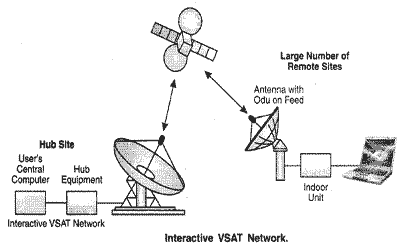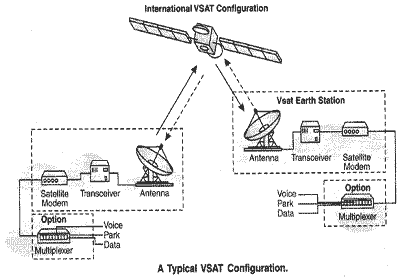Low cost business terminals with small antennas (generally less than 2 metres in diameter) are often termed Very Small Aperture Terminals (VSATs). These are usually perceived as being two way data terminals, though strictly speaking many of the systems used for data broadcast are really one-way VSATs. Taking the USA as an example, approximately half of all installed VSATs are only used for one way data links.
ETSI take a different definition for a VSAT as a one or two-way terminal used in a star, mesh or point to point network. Antenna size is restricted to being less than or equal to 3.8 m at Ku band and 7.8 m at C band.
A more general definition is that a network is a VSAT network if it consists of a large high performance hub earth station (with an antenna of up to 9 m in diameter) and a large number of smaller, lower performance terminals. Being completely general, these small terminals can be receive only, transmit only or transmit / receive. Even this definition is not universal. Meshed VSAT networks exist in which all terminals have the same size and performance.
As terminal technology advances, the size of the antenna required to achieve a particular link quality (bit error rate) decreases. A class of terminals smaller than VSATs is now available; these are termed Ultra Small Aperture Terminals (USATs). For most practical purposes, USATs are just VSATs with smaller antennas. It must always be remembered, however, that as antenna size decreases, the antenna beam widens and that a point is rapidly reached when there is no further advantage in decreasing antenna size because of increased interference with other systems. The practical current lower limit on antenna size is 55 cm diameter.

Typical applications for interactive VSAT networks are:
File transfers; Computer communications;
Database enquiries; Video conferencing;
Reservation systems; Credit checks and credit card verification;
Billing systems; Stock control and management.
Electronic mail; Point of sale transactions.
Overview of Technology
The most common VSAT configuration is the TDM/TDMA star network. These have a high bit rate outbound carrier (TDM) from the hub to the remote earth stations, and one or more low or medium bit rate Time Division Multiple Access (TDMA) inbound carriers. With its star configuration network architecture, interactive VSAT technology is appropriate for any organization with centralized management and data processing.
This configuration has been developed to minimize overall lifetime costs for the complete network including satellite transmission costs. The use of a single high performance hub allows the use of low cost remote VSAT terminals and optimizes use of satellite capacity. Even so, in most VSAT networks, the cost of the VSAT terminals usually far exceeds the cost of the hub (typically a VSAT terminal is 0.1 to 0.2% of the price of the hub).
In a typical VSAT network, remote user sites have a number of personal computers, dumb terminals and printers connected to the VSAT terminal which connects them to a centralized host computer either at the organization’s head office or data processing centre. Data sent to the VSAT terminal from the DTEs is buffered and transmitted to the hub in packets.

The principal characteristics of an interactive VSAT network are:
Remote user sites have several low bit rate data terminal equipments (DTEs) operating ,at 1.2 to 9.6 kb/s. These are connected through the VSAT network to a centralized host processor. The DTEs are connected to the host through an X.25 Packet Assembler/ Dissembler (PAD) or through a conventional or statistical multiplexer which concentrates the traffic.
The amount of data transferred in each transaction is relatively small, typically between 300 and 105 bits. Interactive VSATs are not usually used for batch file transfer (107 to 1011bits per transaction) unless the transmission plan is specifically designed to carry large files.
Each VSAT terminal only operates with a low duty cycle, i.e. with only a relatively small number of transactions in the peak busy hour compared to the total available capacity.
A large number of VSAT terminals (10 to 10000) share the same communications link using random access.
Connections between remote VSAT terminals require a double hop through the hub and are rarely used.
VSAT networks are designed to be flexible and to evolve with user needs. VSAT terminals are controlled by microprocessors and can generally be reprogrammed remotely using downloaded software from the hub. If additional interfaces or capacity are required this can usually be provided by adding or replacing cards in the VSAT terminal.
Three different transmission schemes are used for interactive hubbed VSAT networks:
TDM/TDMA
Demand Assigned SCPC
CDMA
Of these TDM/TDMA is by far the dominant technique with only CDMA being used to a small extent. Demand assigned SCPC has been virtually abandoned as a transmission scheme for the present.
It is also common for VSAT systems to support one-way TV transmission from the host to the remote stations.
Two-way, 2 Mb/s transmissions can also be supported by some VSAT systems.

The main inbound transmission modes used are:
Aloha, in which an IDU can transmit data packets at any time in a particular inbound frequency slot. Transmissions in any particular frequency slot are intermittent with a peak traffic duty cycle of 10 to 15%.
Slotted Aloha, in which an IDU can transmit data packets in any slot (or any of a predetermined number of slots) in a particular inbound frequency slot. Transmissions in any particular frequency slot are intermittent with a peak traffic duty cycle of 25 to 30% .
Fixed Assignment, in which specific time slots in an inbound frequency slot are permanently, r for the duration of a particular transmission, assigned to a particular IDU. This is often used for batch transmission and for telephony. Transmissions in any particular frequency slot are intermittent but can have a peak traffic duty cycle of 100% if that particular inbound is carrying telephony traffic or several batch file transfers from different IDUs.
Dynamic Assignment, in which time slots in an inbound frequency slot are dynamically, assigned to a particular IOU in line with ongoing traffic demands. Transmissions in any particular frequency slot are intermittent with a peak traffic duty cycle of from 25 to 30% to approaching 100%, depending on the traffic mix.
Most interactive hubbed VSATs now have protocol stacks which map, at least notionally, onto the OSI stack.
Network layer spoofing is provided by many VSATs to minimize the impact of the data layer protocol and, particularly, the satellite transmission delay, on the throughput of the satellite link.
 Dinesh Thakur holds an B.C.A, MCDBA, MCSD certifications. Dinesh authors the hugely popular
Dinesh Thakur holds an B.C.A, MCDBA, MCSD certifications. Dinesh authors the hugely popular